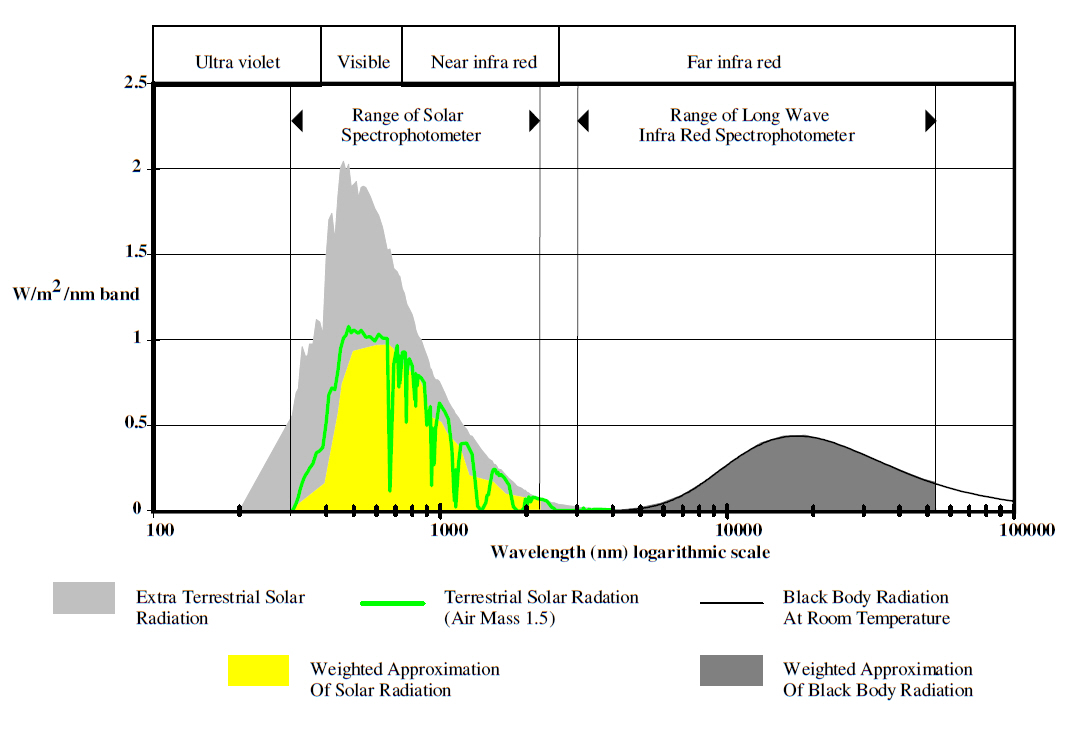Radiation
Contents |
[edit] Introduction
Radiation is a heat transfer mechanism, along with conduction, convection, phase change and mass transfer. All bodies which are hotter than 0°K emit thermal radiation. They also absorb thermal radiation emitted by their surroundings. The difference in the total amount of radiation emitted and absorbed by a body at any given moment may result in a net heat transfer which will produce a change in the temperature of that body.
Thermal radiation includes all those wavelengths of the electromagnetic spectrum which will heat a body when absorbed by it, ranging from about 100nm to 100,000nm. In general, the higher the temperature of a body, the lower the average wavelength of the radiation it emits.
The range of terrestrial temperatures experienced within the built environment is relatively small, and relative to the temperature of the sun this range is ‘cold’ and so radiating at a ‘long’ wavelength compared to the sun. This anomaly allows us to categorise thermal radiation as short-wave solar radiation and terrestrial or long wave infra-red radiation.
[edit] Solar radiation
Solar radiation may be considered to include the ultra violet, visible and near or short wave infra-red wavebands. Around 97% of the solar radiation incident upon the earth's surface is within the range 300 to 2,300nm. Its spectral profile is roughly analogous to that of a black body at 5762°K, and as terrestrial temperatures are unlikely to reach anything like this temperature, solar radiation reaching the earth may be treated as a pure thermal gain.
[edit] Long wave infrared radiation
Most 'terrestrial' radiation occurs within the far or long wave infra-red wavebands. The wavelength of terrestrial radiation varies with temperature, however at room temperature approximately 97% of the radiation emanating from a perfect emitter will be within the range 3,000nm to 50,000nm.
[edit] Nuclear Radiation
Nuclear radiation (also called ionising radiation) is energy released as high-speed charged particles or electromagnetic waves. Radiation can come from many sources, both natural and manufactured. All living things are constantly exposed to low doses of radiation from rocks, sunlight and cosmic rays. There are four major types of radiation: alpha, beta, neutrons, and electromagnetic waves such as gamma rays. There are 3 types of nuclear radiation; Alpha particles, which can only travel short distances and cannot travel through human skin, Beta particles which can penetrate through human skin, but cannot go through your body and Gamma radiation which can go all the way through the human body.
[edit] Greenhouse effect
The difference between long wave infrared radiation and short wave solar radiation produces effects such as the greenhouse effect.
The atmosphere is relatively transparent to solar radiation, this means it allows sunlight to enter the atmosphere and heat the Earth’s surface. These surfaces then re-radiate that heat as long-wave infra-red radiation, which greenhouse gases tend to absorb rather than transmit. The result is that the long-wave infra-red radiation is ‘trapped’ and heat accumulates in the atmosphere causing a warming process.
See greenhouse effect for more information.
[edit] Material properties
The way in which thermal radiation affects different materials is determined by their transmittance, reflectance and absorptance. These properties change for different wavelengths of radiation and for different angles of incidence.
See thermal optical properties for more information.
According to Kirchoff's law the emissivity of a surface is equal to its radiant absorptivity at a given temperature and wavelength.
See emissivity for more information.
[edit] Related articles on Designing Buildings
- Albedo.
- Climate change science.
- Conduction.
- Convection.
- Electromagnetic spectrum.
- Emissivity.
- g-value.
- Heat transfer.
- Low-e glass.
- Phosphorescent building materials.
- Photovoltaics.
- Radiant heating.
- Radiative effect.
- Radiative forcing.
- Shading coefficient.
- Solar gain.
- Solar heat gain coefficient.
- Solar thermal panels.
- Thermal optical properties
- Visible light.
Featured articles and news
RTPI leader to become new CIOB Chief Executive Officer
Dr Victoria Hills MRTPI, FICE to take over after Caroline Gumble’s departure.
Social and affordable housing, a long term plan for delivery
The “Delivering a Decade of Renewal for Social and Affordable Housing” strategy sets out future path.
A change to adoptive architecture
Effects of global weather warming on architectural detailing, material choice and human interaction.
The proposed publicly owned and backed subsidiary of Homes England, to facilitate new homes.
How big is the problem and what can we do to mitigate the effects?
Overheating guidance and tools for building designers
A number of cool guides to help with the heat.
The UK's Modern Industrial Strategy: A 10 year plan
Previous consultation criticism, current key elements and general support with some persisting reservations.
Building Safety Regulator reforms
New roles, new staff and a new fast track service pave the way for a single construction regulator.
Architectural Technologist CPDs and Communications
CIAT CPD… and how you can do it!
Cooling centres and cool spaces
Managing extreme heat in cities by directing the public to places for heat stress relief and water sources.
Winter gardens: A brief history and warm variations
Extending the season with glass in different forms and terms.
Restoring Great Yarmouth's Winter Gardens
Transforming one of the least sustainable constructions imaginable.
Construction Skills Mission Board launch sector drive
Newly formed government and industry collaboration set strategy for recruiting an additional 100,000 construction workers a year.
New Architects Code comes into effect in September 2025
ARB Architects Code of Conduct and Practice available with ongoing consultation regarding guidance.
Welsh Skills Body (Medr) launches ambitious plan
The new skills body brings together funding and regulation of tertiary education and research for the devolved nation.
Paul Gandy FCIOB announced as next CIOB President
Former Tilbury Douglas CEO takes helm.
UK Infrastructure: A 10 Year Strategy. In brief with reactions
With the National Infrastructure and Service Transformation Authority (NISTA).























